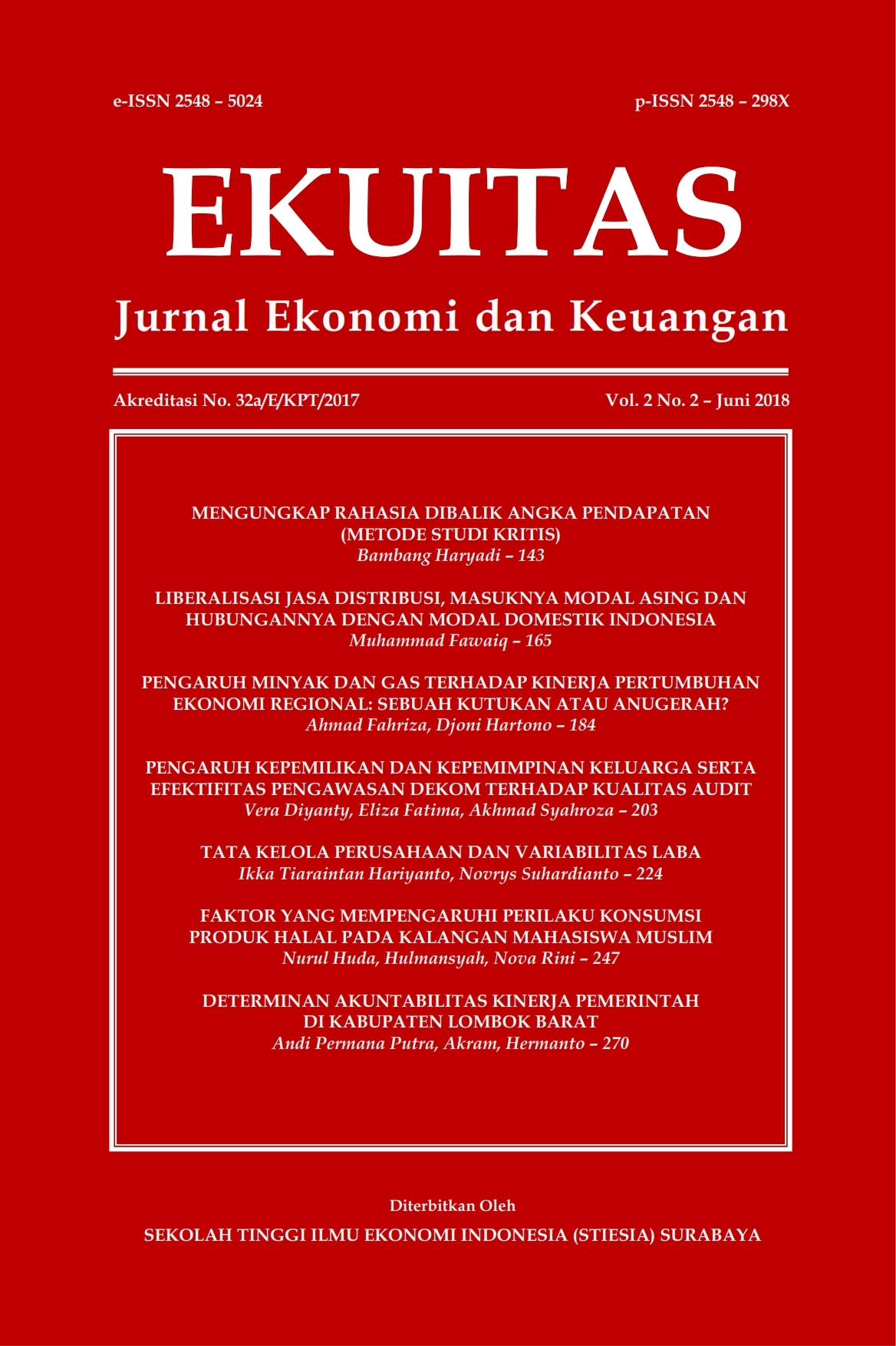PENGARUH MINYAK DAN GAS TERHADAP KINERJA PERTUMBUHAN EKONOMI REGIONAL: SEBUAH KUTUKAN ATAU ANUGERAH?
DOI:
https://doi.org/10.24034/j25485024.y2018.v2.i2.3940Keywords:
Indonesia, resource-curse, oil and gas, GRDP growth per capitaAbstract
Natural resources, particularly oil and gas, are great benefit to the region that owns it and become one of the region's revenue sources. Nevertheless, Sachs and Warner (1995) found a phenomenon of natural resource curse indicating that the wealth of natural resources could hamper the economic growth. This research tries to see the existence of natural resource curse phenomenon in Indonesia through the performance of regional economic growth; and observes the differences of oil and gas contribution in the economic structure as an indicator of natural resource wealth in the area. Gross Regional Domestic Product Growth (PDRB) per capita without oil and gas is an indicator of the economic growth to see if the oil and gas are inhibiting or accelerating the growth of other sectors in the region's economy. Using data from 33 provinces in Indonesia within the period of 2006-2013, this study found a positive relationship between oil and gas contribution and per capita GDP growth without oil and gas. Based on these findings, natural oil and gas resources have become a boon to the province that owns them.References
Atkinson, G. dan K. Hamilton. 2003. Savings, Growth and the Resource Curse Hypothesis. World Development 31(11): 1793-1807.
Auty, R. M. 1994. Industrial Policy Reform in Six Large Newly Industrializing Countries: The Resource Curse Thesis. World Development 22(1): 11-26.
Badan Pusat Statistik. 2016. Statistik Indonesia 2016. Jakarta, Indonesia. www.bps.go.id.
Barro, R. 2003. Determinants of Economic Growth in a Panel of Countries. Annals of Economics and Finance 4(2): 231-274.
Bjorvatn, K., M. R. Farzanegan, dan F. Schneider. 2012. Resource Curse and Power Balance: Evidence from Oil-Rich Countries. World Development 40(7): 1308-1316.
Boschini, A. D., J. Pettersson, dan J. Roine. 2007. Resource Curse or Not: A Question of Appropriability. Scandinavian Journal of Economics 109: 593-617.
Brunnschweiler, C. N. dan E. H. Bulte. 2009. Natural Resources and Violent Conflict: Resource Abundance, Dependence, and the Onset of Civil Wars. Oxford Economic Papers 61(4): 651–674.
Cavalcanti, T. V. D. V., K. Mohaddes, dan M. Raissi. 2011. Growth, Development and Natural Resources: New Evidence Using A Heterogeneous Panel Analysis. The Quarterly Review of Economics and Finance 51(4): 305-318.
Collier, P. dan A. Hoeffler. 1998. On Economic Causes of Civil War. Oxford Economic Papers 50(4): 563-573.
Costa, H. K. M. dan E. M. Santos. 2013. Institutional Analysis and the “Resource Curse” in Developing Countries. Energy Policy 63: 788-795.
Davis, G. 2011. The Resource Drag. Institute for European Environmental Policy 8: 156-176.
Ebrahimzadeh, C. 2012. Dutch Disease: Wealth Managed Unwisely. International Monetary Fund. http://www.imf. org/external/pubs/ft/fandd/basics/dutch.htmDiakses tanggal 16 Juli 2016.
Fan, R., Y. Fang, dan S. Y. Park. 2012. Resource Abundance and Economic Growth in China. China Economic Review 23(3): 704-719.
Gylfason, T. 2001. Natural Resource, Education, and Economic Development. European Economic Review 45(4-6): 847-859.
Holden, S. 2013. Avoiding the Resource Curse the Case Norway. Energy Policy 63: 870-876.
Hodler, R. 2006. The Curse of Natural Resources in Fractionalized Countries. European Economic Review 50(6): 1367-1386.
Humphreys, M., J. D. Sachs, dan J. E. Stiglitz. 2007. Escaping the Resource Curse. Columbia University Press. New York.
James, A. G. dan R. G. James. 2011. Do Resource Dependent Regions Grow Slower Than They Should?. Economics Letters 111(3): 194-196.
James, A. 2015. The Resource Curse: a Statistical Mirage. Journal of Development Economics 114: 55-63.
Komarulzaman, A. dan A. S. Alisjahbana. 2006. Testing the Natural Resource Curse Hypothesis in Indonesia: Evidence at the Regional Level. Working Paper in Economics and Development Studies No 200602. Department of Economics, Padjajaran University.
Kementerian Energi dan Sumber Daya Mineral. 2016. Handbook of Energy and Economic Statistics of Indonesia 2016. http://www.esdm.go.id/.
Mankiw, N. G. 2012. Principles of Economics. South Western Cengage Learning. USA.
Mehlum, H., K. Moene, dan R. Torvik. 2006. Institutions and the Resource Curse. The Economic Journal 116(508): 1–20.
Mideksa, T. K. 2013. The Economic Impact of Natural Resources. Journal of Environmental Economics and Management 65(2): 277-289.
Murshed, S. M. dan L. A. Serino. 2011. The Pattern of Specialization and Economic Growth: The Resource Curse Hypothesis Revisited. Structural Change and Economic Dynamics 22(2): 151-161.
Papyrakis, E. dan R. Gerlagh. 2007. Resource Abundance and Economic Growth in The United States. European Economic Review 51(4): 1011-1039.
Pick, D. dan H. H. Thein. 2010. Development Failure and the Resource Curse: the Case of Myanmar. International Journal of Sociology and Social Policy 30(5/6): 267-279.
Ross, M. L. 2015. What Have We Learned about the Resource Curse. Annual Review of Political Science 18(1): 239-259.
Rosser, A. 2004. Why did Indonesia Overcome the Resource Curse?. Institute of Development Studies Working Paper 222.
Sachs, J. D. dan A. M Warner. 1995. Natural Resource Abundance and Economic Growth. NBER Working Paper 5398. National Bureau of Economic Research.
Sachs, J. D. dan A. M. Warner. 2001. The Curse of Natural Resource. European Economic Review 45(4-6): 827-838.
Torvik, R. 2002. Natural Resources, Rent Seeking and Welfare. Journal of Development Economics 67(2): 455-470.














